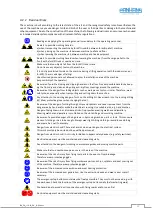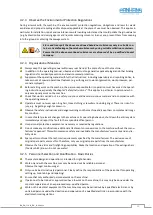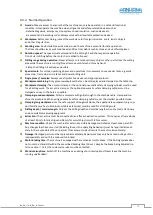
BA_PH_116-10_EN_12-22.docx
20
5.2
Working Area
The working area designates the position from which the ma-
chine is operated during operation.
This position is on the rear of the machine, so that the two
control levers for the longitudinal and transverse movement
of the drill unit are easily accessible.
•
The longitudinal movement
when drilling into the
workpiece is towards the table top.
•
The transverse movement
when drilling
a mortise is towards both sides.
Note:
On machines with the “single-lever operation” option (see
chapter
16 “Options and Accessories”), narrow workpieces
can also be machined from the table side.
Figure 3: Working area
5.3
Emission Levels
5.3.1
Noise Information
The values given are emission levels and therefore do not necessarily represent safe workstation values at the
same time. Although there is a correlation between emission and immission levels, it cannot be reliably deduced
whether additional precautionary measures are necessary or not.
Factors that may affect the current immission level at the workstation include the duration of exposure, the
nature of the workspace, other noise sources (e.g. the number of machines and other adjacent operations). The
permissible workstation values can also vary from country to country.
However, this information should enable the user to make a better assessment of hazard and risk.
5.3.2
Noise Emission Values
•
The measured values given are determined according to DIN 45635 part 1662.
•
The noise values given are based on individual measurements.
•
Series scattering of + 3 dB(A) can occur.
Workplace-related emission value
Idle 68.3 dB(A)
Operation 74.3 dB(A)
As soon as the noise emission values of the machine exceed 85 dB(A), suitable hearing
protection must be made available to the personnel!
Workplace-related dust emission value:
0.25 mg/m³ air.
Working area






























